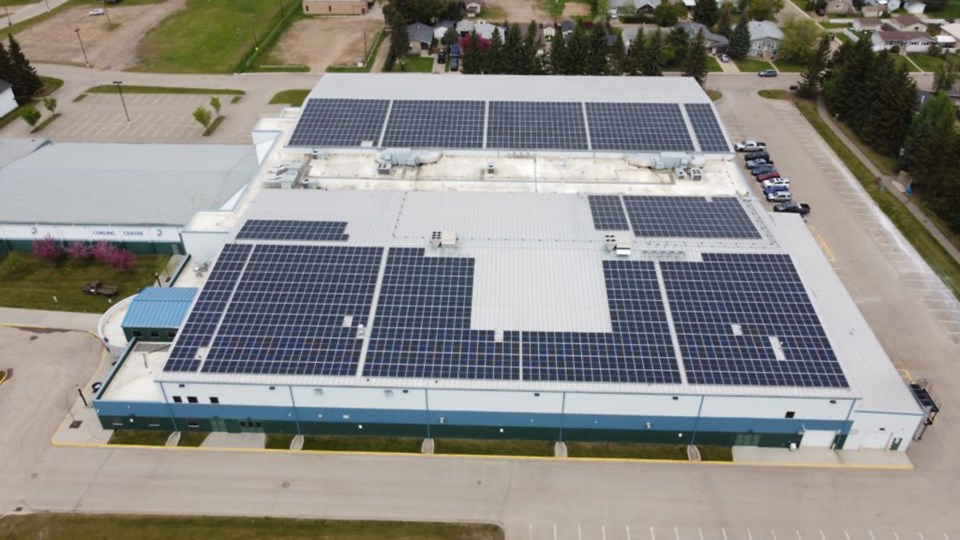WESTLOCK – The $1.18 million, 625 kW, 1,623-solar-panel array that’s been atop the Rotary Spirit Centre (RSC) since February 2020, has produced 1,761 mWh of electricity up to the end of 2022, with 1,063 mWh being consumed by the facility and 699 mWh sold back to the grid.
And while the array has generated $59,732.89 in “total energy saving” and $76,936.57 in “energy microgen credits”, when principal and interest repayments of $157,951.42 are factored in, the project has cost the municipality $21,281.96 since installation — original estimates stated the panels would post an annual $5,400 deficit for the first handful of years.
Those are just some of the statistics presented by director of finance Julia Seppola during her 20-plus-minute presentation to town councillors at their April 17 committee of the whole meeting which was accepted as information. In late 2019, council of the day agreed to go ahead with $1,184,181.38 project which was funded via a $511,213 Municipal Climate Change Action Centre grant and a 15-year, $672,967 debenture from ENMAX, the company which continues to maintain the array as part of a 15-year contract.
“I think it’s coming out as predicted and I think we were careful not to be overly optimistic in our projections,” said mayor Ralph Leirger. “It’ll be interesting to watch this throughout its lifespan. I see this as the total amount of cost over the 15 years and then seeing how much we can make on them and then start turning a profit.”
In a follow-up interview, CAO Simone Wiley agreed, saying the project is “trending in the right direction” and they knew it was a “long-term commitment and investment.”
“It’s performing as it was predicted to. We felt that ENMAX was very conservative and realistic and three years later we can say they were right,” said Wiley.
Seppola noted that if she had subtracted out the principal and interest repayments “keeping in mind this is an asset that we own” and took just interest into account, “we’d see a net savings for sure because the principal is repaying something that we own.”
Her presentation also notes additional savings due to the panels as they were able to reduce the RSC transformer from 1,000kVA to a 500kVA and states that comparing the energy and delivery costs between 2019, which was before the system install, and 2022 (contract pricing was the same for both years), there is a difference of $43,147 for energy and $4,620 for delivery.
And while councillors would have liked a break-even number, they know the debenture includes the maintenance package and view this is a long term-term investment as the array has a 25-year lifespan. Ultimately, Seppola says what’s kept the project from generating revenue so far is the contract price of the electricity they’ve sold back to the grid, which will be changing at the end of the year.
“As the price of power will only go up over the next 12 years, renewables become more viable. So, the next three years potentially put us $20,000 to the black, not because we’re generating more power, but because the price has changed,” said Coun. Murtaza Jamaly.
Previously, ENMAX claimed the panels would ultimately lead to cumulative savings of up to $600,000 over the next 25 years, based on the 2018 consumption and rates, and offset approximately 31 per cent of the electricity required to power the facility. During debate, community services manager Gerry Murphy said while “there’s been some operational issues” with the panels, “they’ve been navigated” adding there’s been “nothing out of the norm as far as maintenance to the facility.”
“We have 12 years left and need to go down this process every couple of years to see if we’re still on the mark. This is potentially our worst three years because of the low contract price, so I’m excited to see what the next three years are like, but the critical years are years 16 to 20 because when the principal is paid off, you’re not talking about a few thousand dollars to the red or the black, you’re talking about 150 grand in your pocket every year,” said Jamaly.
Wiley said they’re currently “investigating what our options are” for some kind of solar array at the new public works shop, but admitted any project there would be contingent on grant dollars as “that’s the only way it would work.”
“With the new technologies that are out there, there’s got to be something we could do around the perimeter of the site, or on the land, but it’s still in the investigation stage at this point,” said Wiley.



